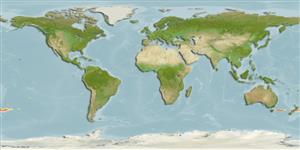Teleostei (teleosts) >
Argentiniformes (Marine smelts) >
Opisthoproctidae (Barreleyes or spookfishes)
Etymology: Monacoa: The name constructed by Whitley was without any etymological reason; however, it is likely referring to the state of Monaco, in which the research expedition that sampled the two syntypes originated; griseus: Name from Latin 'griseus' for 'grey'; referring to the uniform greyish anterior part of the sole lacking distinct patterns of pigmentation.
Environment: milieu / climate zone / depth range / distribution range
Ecology
Marine; bathypelagic; depth range 0 - 521 m (Ref. 111070). Deep-water
Distribution
Countries | FAO areas | Ecosystems | Occurrences | Point map | Introductions | Faunafri
Southwest Pacific: New Zealand and possibly Australia.
Size / Weight / Age
Maturity: Lm ? range ? - ? cm
Max length : 6.4 cm SL male/unsexed; (Ref. 111070)
Short description
Identification keys | Morphology | Morphometrics
This species is distinguished by the following characters: a greyish anterior part of the sole, abruptly changing just in front of the pelvic fins, to a dense pigmented posterior part; two adult specimens show in addition, a relatively weak irregular large blotch just in front of the change in pigmentation, centered approximately below the anterior part of the dorsal fin in the vertical plane; scale pockets possibly relatively light (Ref. 111070).
Life cycle and mating behavior
Maturity | Reproduction | Spawning | Eggs | Fecundity | Larvae
Poulsen, J.Y., T. Sado, C. Hahn, I. Byrkjedal, M. Moku and M. Miya, 2016. Preservation obscures pelagic deep-sea fish diversity: doubling the number of sole-bearing opisthoproctids and resurrection of the genus Monacoa (Opisthoproctidae, Argentiniformes). Plos One 11(8):1-23. (Ref. 111070)
IUCN Red List Status (Ref. 130435: Version 2024-2)
Threat to humans
Harmless
Human uses
Tools
Special reports
Download XML
Internet sources
Estimates based on models
Phylogenetic diversity index (Ref.
82804): PD
50 = 0.6250 [Uniqueness, from 0.5 = low to 2.0 = high].
Bayesian length-weight: a=0.02239 (0.00864 - 0.05802), b=2.98 (2.75 - 3.21), in cm total length, based on LWR estimates for this (Sub)family-body shape (Ref.
93245).
Trophic level (Ref.
69278): 3.4 ±0.1 se; based on size and trophs of closest relatives
Resilience (Ref.
120179): High, minimum population doubling time less than 15 months (Preliminary K or Fecundity.).
Fishing Vulnerability (Ref.
59153): Low vulnerability (10 of 100).
